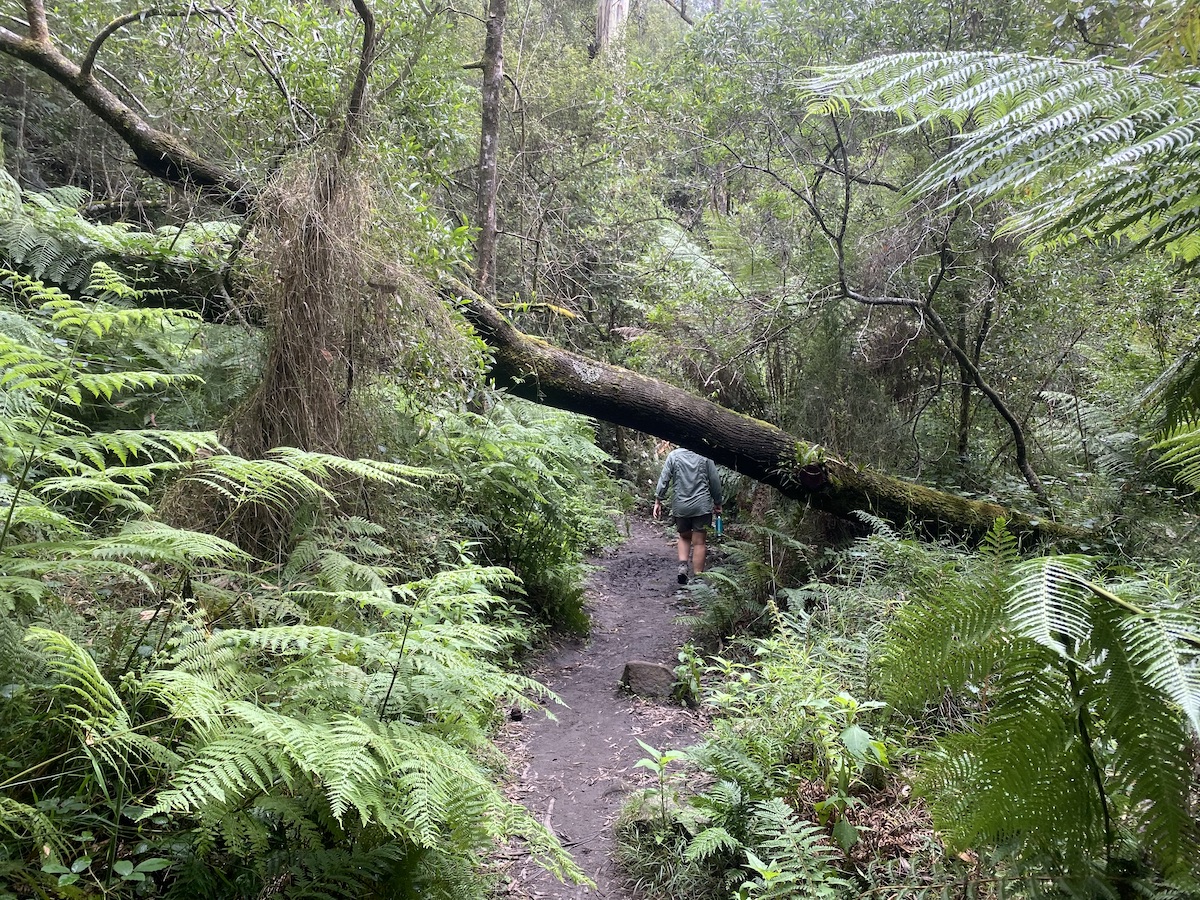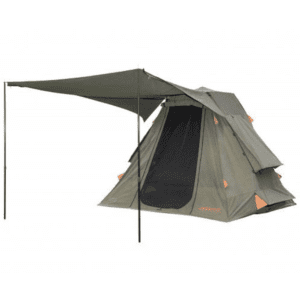Note: This article contains an affiliate link to Outback Equipment. If you click through and make a purchase, we earn a small commission at no extra cost to you.
Rainforest running down to the ocean conjures up imagines of the Daintree in Far North Queensland. Tropical rainforests, white sandy beaches and crystal-clear waters.
But who’d have thought Great Otway National Park at the bottom of Victoria would offer a similar experience?
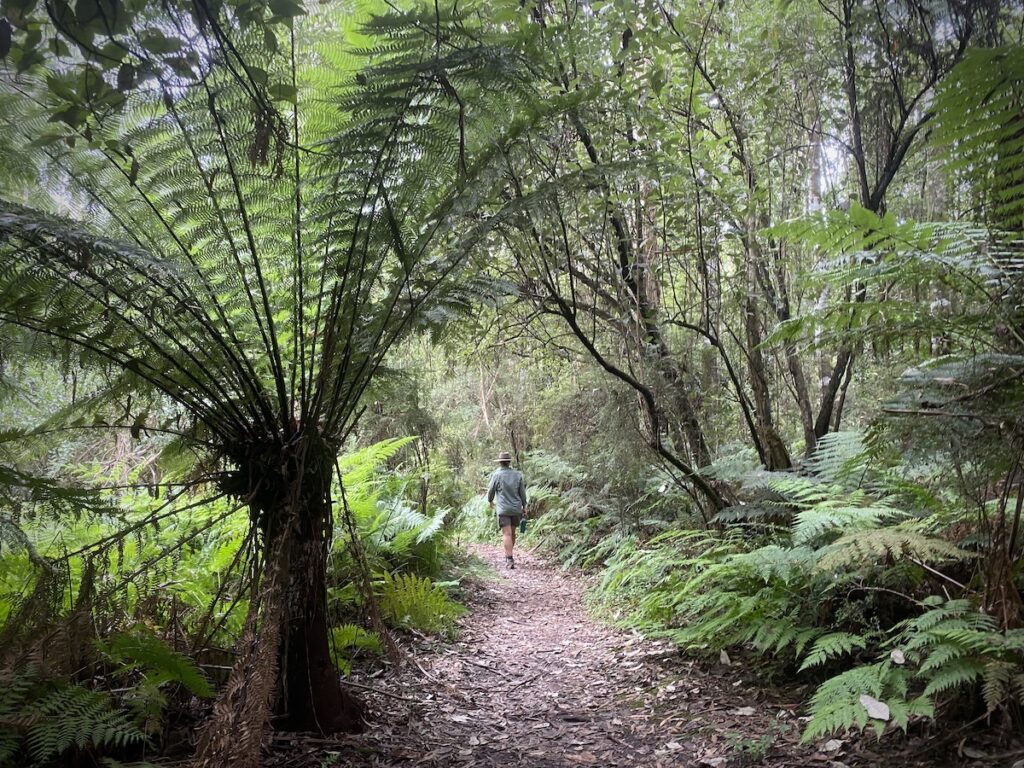
We had no idea how much the Otways has to offer:
- Lush rainforests,
- Magnificent waterfalls,
- Bushwalking,
- Mountain biking,
- 4WDing,
- Horse riding,
- A treetop walk and the Otway Fly, a zip-line through the trees.
Okay, so the Otways might be missing the tropical rainforest and the tropical climate of the Daintree. And yes, the ice cold Southerly winds could blow a dog off its chain at times.
Yet the Otways has its own majesty – cool temperate rainforest and a rugged coastline fighting an endless battle with the wild Southern Ocean. And so much of the national park is accessible. Parks Victoria have achieved a good balance between protecting the environment and giving the public lots of access.
We were here to see the rainforest… visit the famed waterfalls, walk some tracks, and hopefully camp among the cool temperate rainforest.
What we hadn’t reckoned on was the sheer number of waterfalls, hiking tracks and campgrounds. There’s so much to see!
Let’s find out more about this place. Where is Great Otway National Park and how do you get there?
Getting To Great Otway National Park
First up, let’s sort out the name of this national park. It’s pretty confusing!
The official name is the Great Otway National Park. It’s also known as the Otways or the Otways National Park.
The Great Otway National Park was born in 2004 when the Victorian Government combined several state forests, state parks and reserves into one large national park. The result? A patchwork of national park land which sort of follows the Otway Ranges.
Great Otway National Park broadly covers the hinterland of the Otway Ranges, between Torquay and Princetown (which is near the famous Twelve Apostles).
The Great Ocean Road hugs the coastline along the edge of the Otway Ranges. The Ranges rise directly up from the coast, providing the spectacular scenery the Great Ocean Road is famous for.
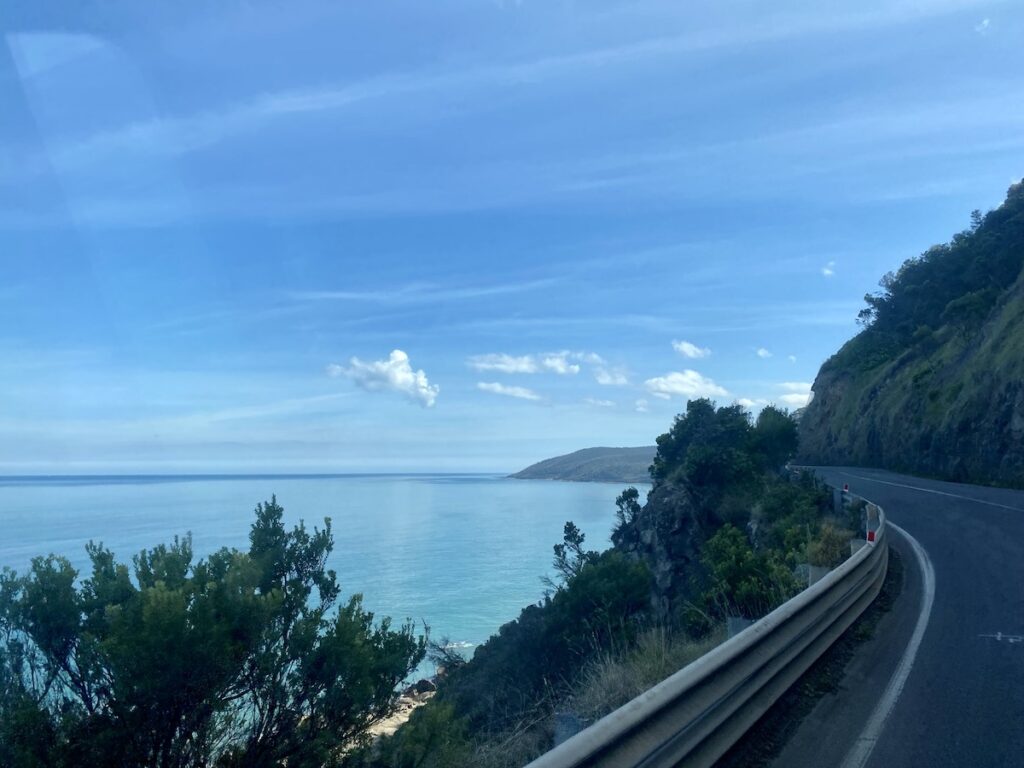
A Direct Link To The Dinosaurs – For Now
Because they face south (roughly), the ranges both protect the remnant cool temperate rainforest and promote bucketloads of rainfall. Sadly, much of the old-growth rainforest is gone, a victim of intensive logging and clear-felling over many years.
However, small patches still cling on tenaciously in southern-facing valleys.
Thankfully some of these are protected within the national park. However, they still face threats from disease, climate change, and the long term effects of land clearing.
These old growth rainforests are a direct link back to Gondwanaland, 140 million years ago. Dinosaurs lived among the ancestors of these ecosystems.
Yet we’ve pretty much wiped them out in less than 200 years.
One of the main canopy trees is the myrtle beech tree. It evolved to grow in damp environments, so both the trees and their seeds aren’t resistant to bushfires… once they burn, they’re done for. So whichever way you look at it, these remnant rainforests face a bleak future.
For now, you can still experience the beauty of these rainforests. And there’s nothing quite like camping among the rainforest.
Camping and Facilities
As you might expect, you have dozens of camping options along the Great Ocean Road. And since the Great Ocean Road and Great Otway National Park are intertwined, you’ll find some of these campgrounds aren’t within the National Park.
We’ll start with the paid options.
Caravan Parks and Private Campgrounds
Nearly every town from Torquay to Princetown has at least one caravan park. We stayed in a few. The only one we’d recommend is the Big 4 at Aireys Inlet.
The others? Our experience wasn’t great – they were way overpriced, run down, unfriendly, and the staff didn’t want to be there. That’s not to say they’re all like that… however, it was disappointing.
There are plenty of private campgrounds dotted along the Great Ocean Road, too many to list here. Facilities range from basic bush camping with a drop toilet to full amenities. They could be a good alternative to the caravan parks. If you do a quick Google search, you should find something to suit your needs and budget.
Campgrounds In or Around Great Otway National Park
The campsites covered here are either in or adjacent to Great Otway National Park. Some are first come, first served while you’ll need to book the others through Parks Victoria.
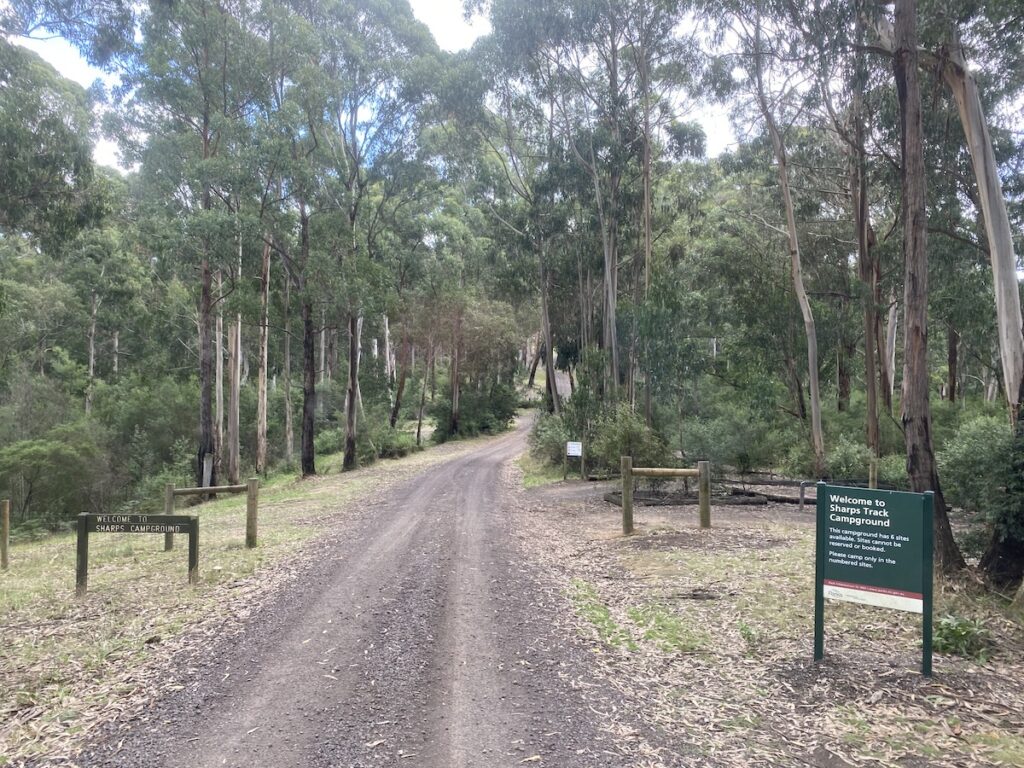
The Otways are extremely busy on weekends and school holidays. So make sure you either book early or arrive early at the non-bookable campgrounds.
It can be difficult to figure out which campsites listed on the Parks Victoria website are suitable for your setup. Here’s a few helpful tips:
- Browse the bookable campgrounds in Great Otway National Park here.
- The Great Ocean Walk campgrounds are all hike-in campgrounds.
- Click on “Visit Campsite”. Here you’ll find a location map, whether its suitable for caravans, campers or motorhomes, facilities, and nearby attractions.
Bookable Parks Victoria campgrounds:
- All the hike-in campgrounds on the Great Ocean Walk.
- Aire River West Campground.
- Aire River East Campground.
- Blanket Bay Campground.
- Lake Elizabeth Campground.
- Johanna Beach Campground.
- Parker Hill Campground.
- Jamieson Creek Campground.
- Hammond Road Campground.
- Allenvale Campground.
- Big Hill Campground.
Other campgrounds:
- Sharps Camping Area
- Stevenson’s Falls Campground
- Beauchamp Falls Campground
- Dandos Camping Ground
- Aire Crossing Campsite
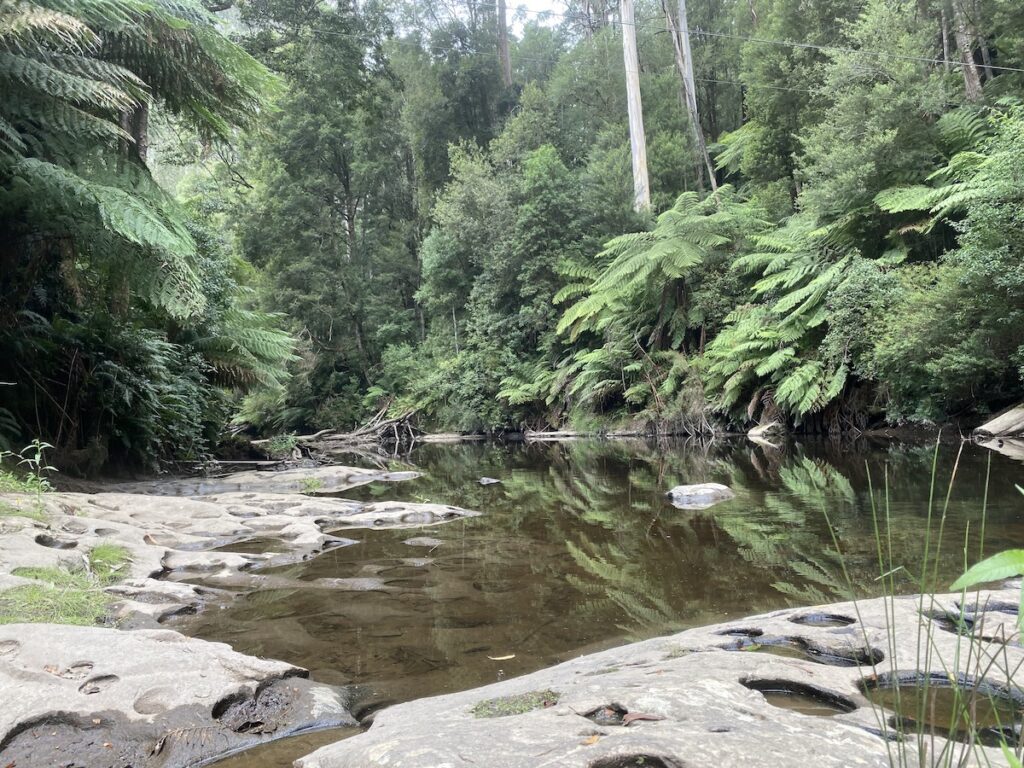
Click on any of the blue pins shown below to find out more about each campsite.
When To Visit The Otways
You can visit the Otways any time of year. However, the best time is March – April. Chances are, the weather will still be warm and you’ll miss the freezing winter winds blowing up from Antartica.
If you’re into peace and quiet, I’d suggest visiting during the week. Melbourne and Geelong are less than 3 hours away, so the entire Great Ocean Road is extremely busy on weekends… including the campgrounds.
We split our visit to the Otways by arriving on a Monday, exploring until Friday, and staying at Port Fairy (a great spot) over the weekend. Then we resumed our Otways adventures the following Monday.
If you’re into exploring the 4WD tracks, they’re subject to seasonal track closures – usually mid June to the end of October.
Go here for maps of seasonal track closures in the Otways.
What To See in Great Otway National Park
There’s no doubt, the incredibly beautiful waterfalls are the main drawcards of Great Otway National Park.
If you travel from the Torquay end (north-western end), you’ll notice the Otways become progressively wetter and more lush. Pretty soon you’ll be surrounded by thick stands of tree ferns, huge rainforest trees, and all sorts of beautiful mosses, lichens and fungi.
Throw in a waterfall or three and you have the ideal recipe for stunning scenery.
The best way to see the Otways National Park up close and personal is to do some walks. We’ll concentrate on some of these. However, there are so many walks in the Otways, it’s hard to know where to start!
Most walks meander through lush rainforests and end at magnificent waterfalls. Not all, however…
Yan Wirring Mirr Loop Walk
Difficulty – moderate, 1½ hrs, 4.5km.
Yan wirring mirr means walk, listen, look in the Wadawurrung language. That’s always good advice when you’re walking in the bush. You never know what you’ll encounter if you take time to look around and listen to the sounds of the bush.
It’s an exposed walk through coastal heathland. You’ll get great views across to the coast at Anglesea… and a not so great view of the old coal mine and power station, now rehabilitated.
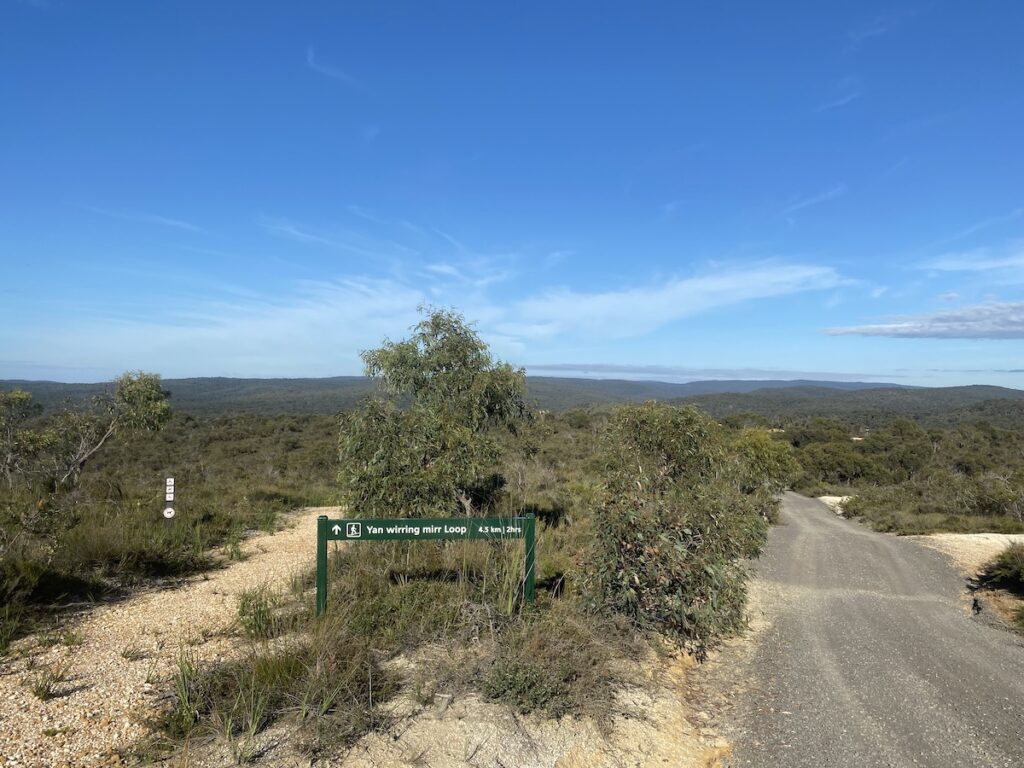
Keep an eye out for honeyeaters, wrens, crimson rosellas, skinks, and dragons. And if you’re there at the right time (usually spring), you’ll see a wide variety of native plants flowering.
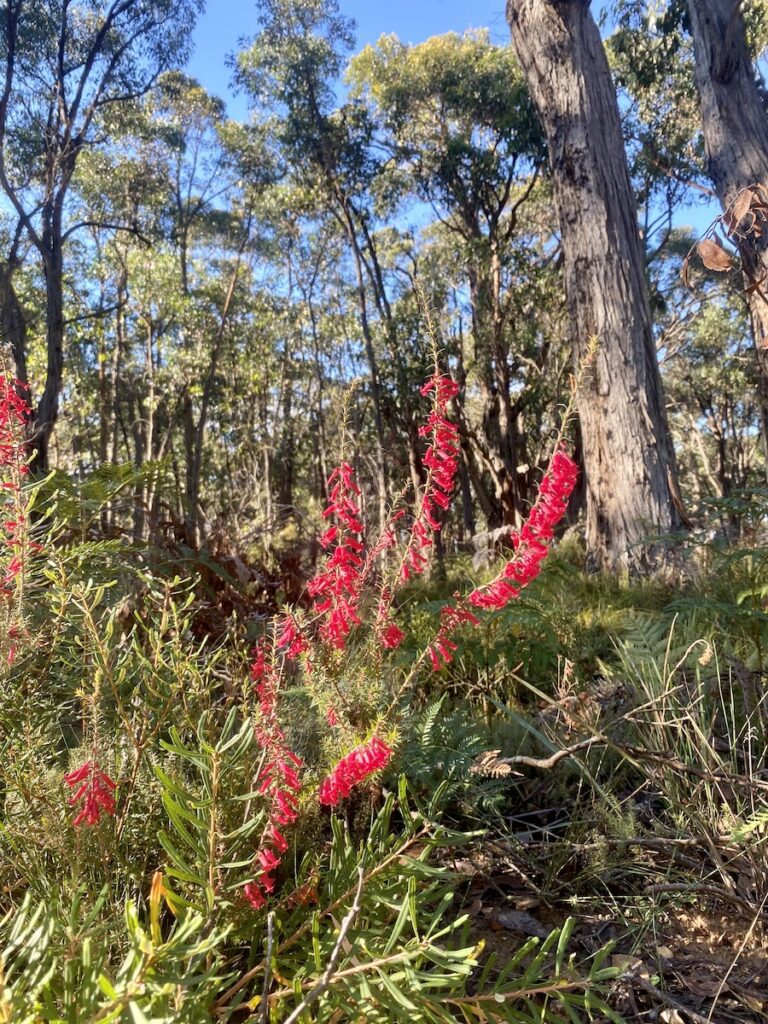
Moggs Creek Circuit Walk
Difficulty – easy, ½ hr, 2.1km.
This easy loop walk starts at Moggs Creek Picnic Area, just inland from Aireys Inlet. The track crosses Moggs Creek then cuts around a steep slope before crossing back over Moggs Creek to the picnic area.
It’s an ideal introduction to the beauty of the Otways. Huge old rainforest eucalypts shelter an under-storey of lush ferns… it’s like entering another world.
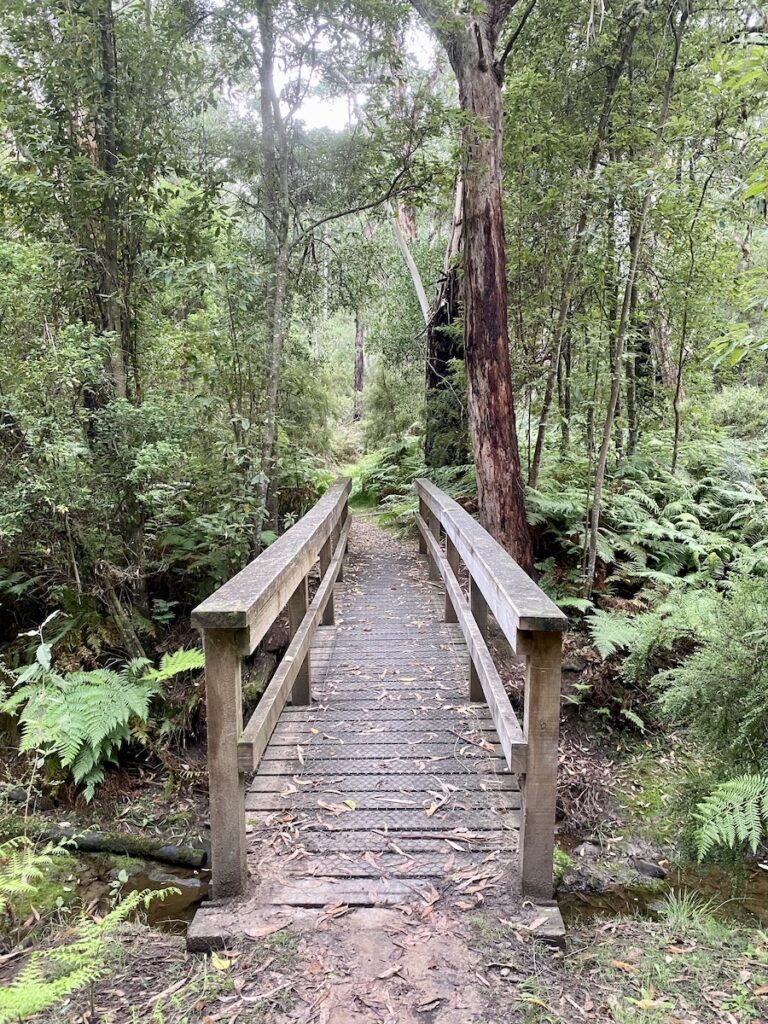
Phantom Falls Walk
Difficulty – moderate, 1½ hr, 3.5km return.
Phantom Falls Walk starts at Allenvale Campground. You can do an 8km walk to Sheok Picnic Area or walk to Phantom Falls then turn around and come back.
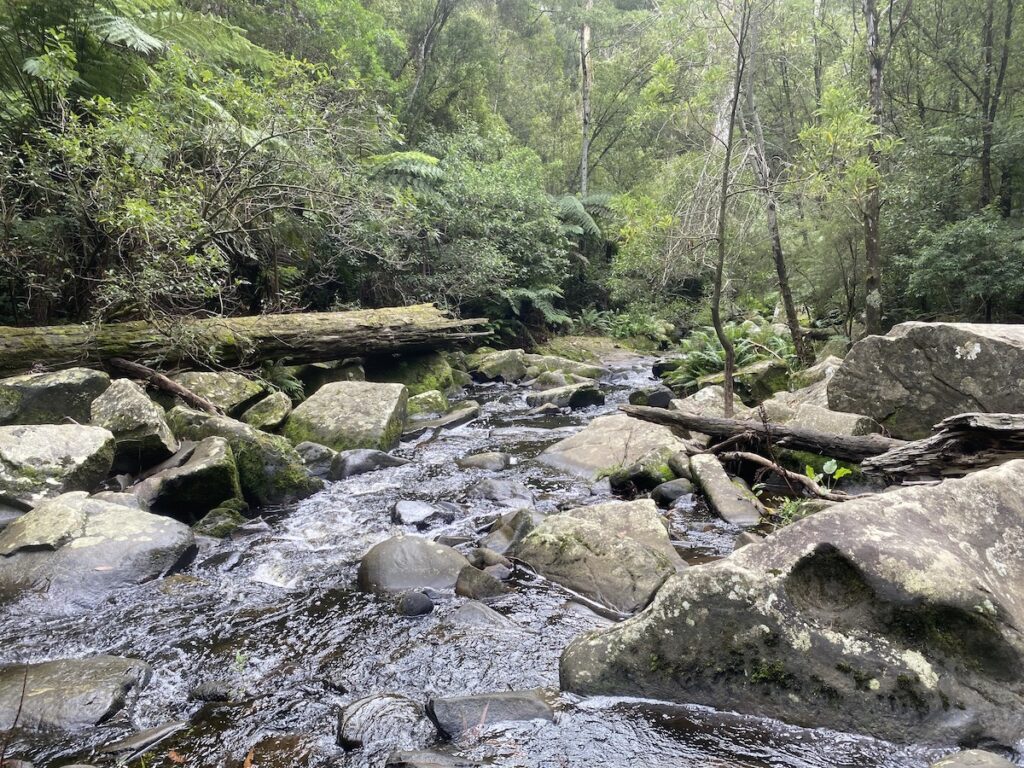
The walk follows St George River most of the way. When you start out, you’ll cross a footbridge and find yourself in an orchard! Follow the markers… which strangely take you past the front door of someone’s farmhouse and then onwards to Phantom Falls.
The walking track follows an access track for a water supply pipe. It gets steep in places, so you’ll need to be reasonably fit.
At the end, you’re rewarded with a stunning view of Phantom Falls. You can make your way down to the base of the falls via steps and a track.
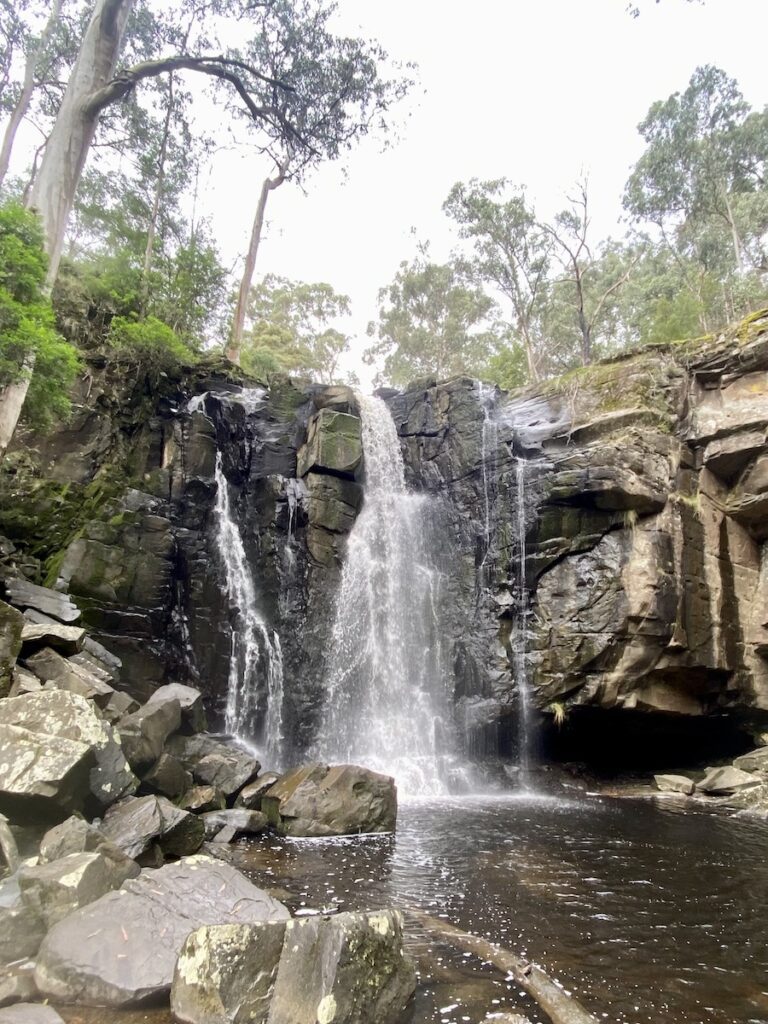
Henderson Falls Walk
Difficulty – moderate, 1½hr, 3km return.
Starting at Sheoak Picnic Area, Henderson Falls Walk takes you deep into a small rainforest valley. The track meets up with Henderson Creek. The bush turns to rainforest and closes in until you’re surrounded by tree ferns and all sorts of mosses and fungi.
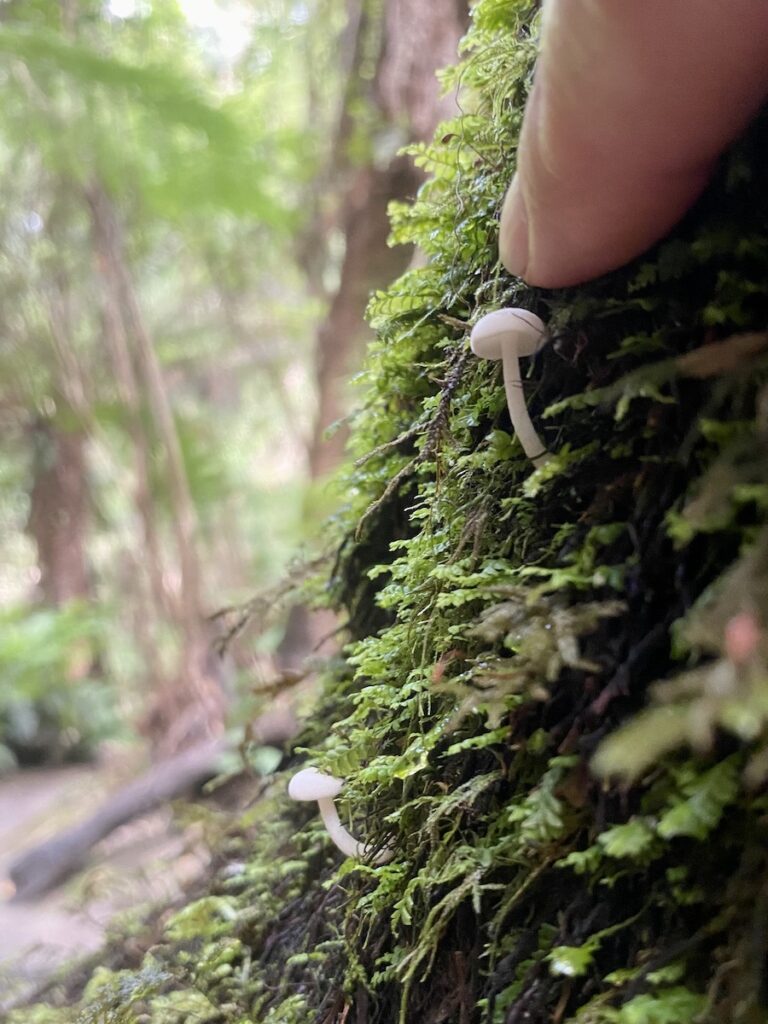
The track ends at base of the Falls… a piece of paradise surrounded by lush ferns. This was our favourite walk, no doubt about that.
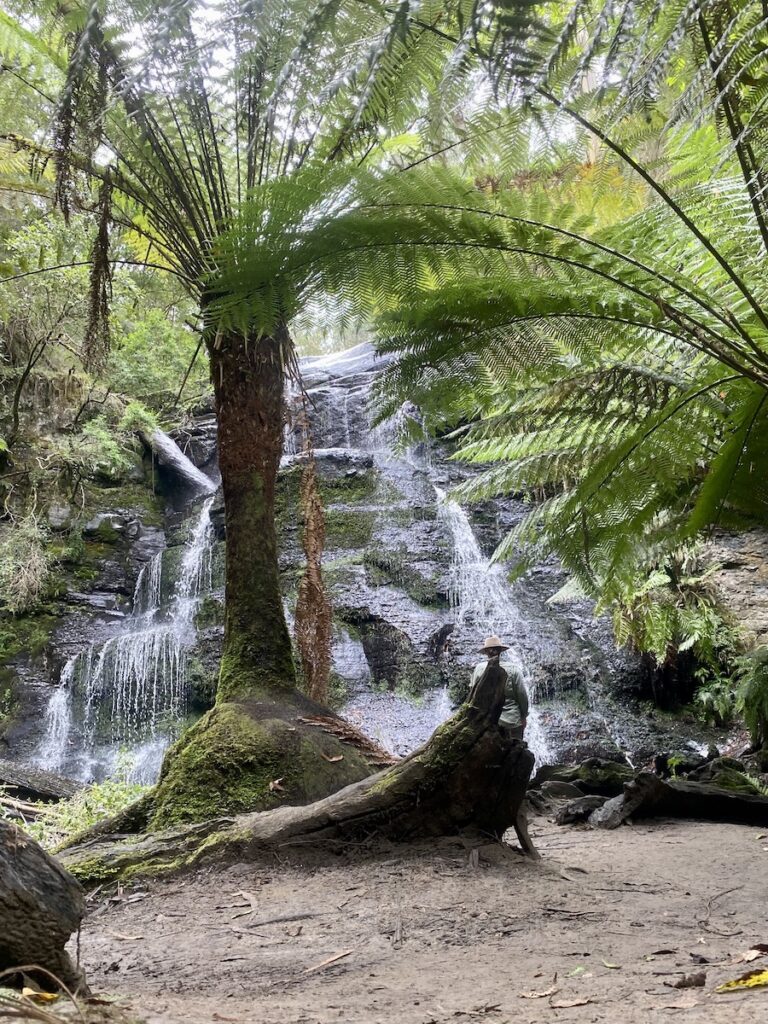
Sheoak Creek Nature Walk Loop
Difficulty – easy, 30min, 1.3km.
Once back at Sheoak Picnic Area, take the Nature Walk. This easy walk is an excellent introduction to the rainforest country of the Otways. Interpretive signage along the track explains more about various rainforest plants and animals that call this area home.
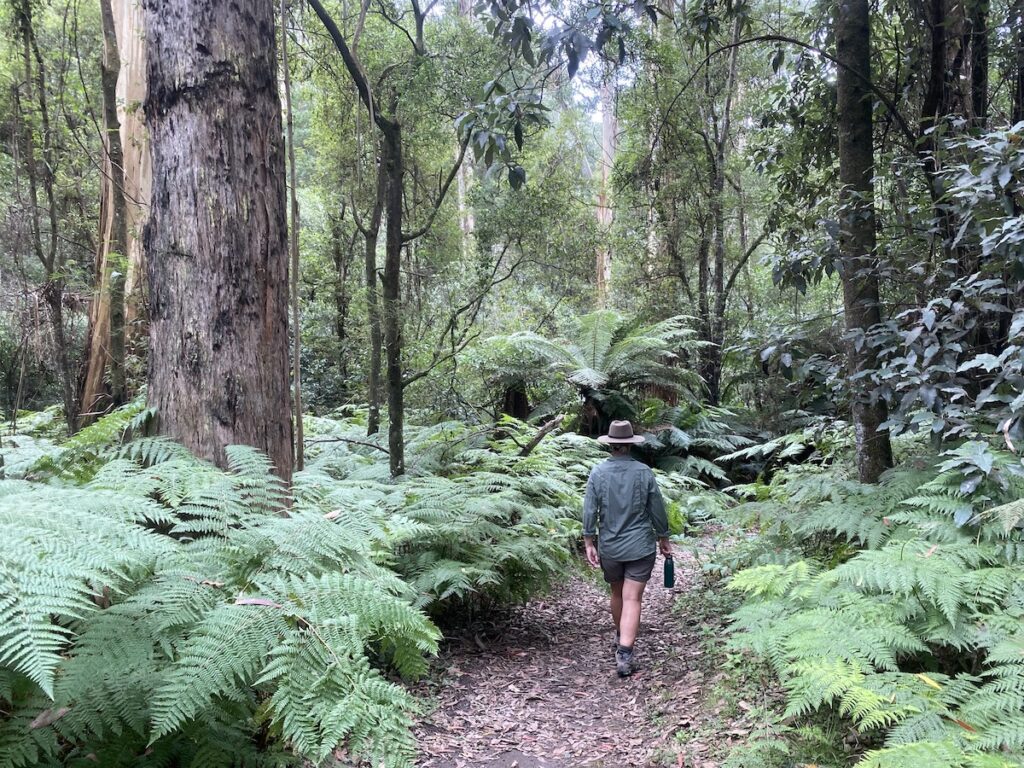
Sheoak Falls and Swallow Cave Walk
Sheaok Falls: Difficulty – difficult, 30mins, 1.4km return.
Swallow cave: Difficulty – difficult, 50mins, 2.2km return.
You can walk to Sheoak Falls and Swallow Cave from Sheoak Picnic Area. However, we chose to drive to the carpark just south of Lorne on the Great Ocean Road and walk in from there.
This walk is brutal! The walking track leaves the carpark, goes up and over a ridge, follows Sheoak Creek for a bit, then goes up… and up and up. It felt like there were at least ten million steps – although maybe it wasn’t quite that many!
By the time we reached Sheoak Falls, we lifted our heads, said “Yep, there it is”, then put our heads down and pushed ever upwards to Swallow Cave. Six million steps later and we made it to Swallow Cave.
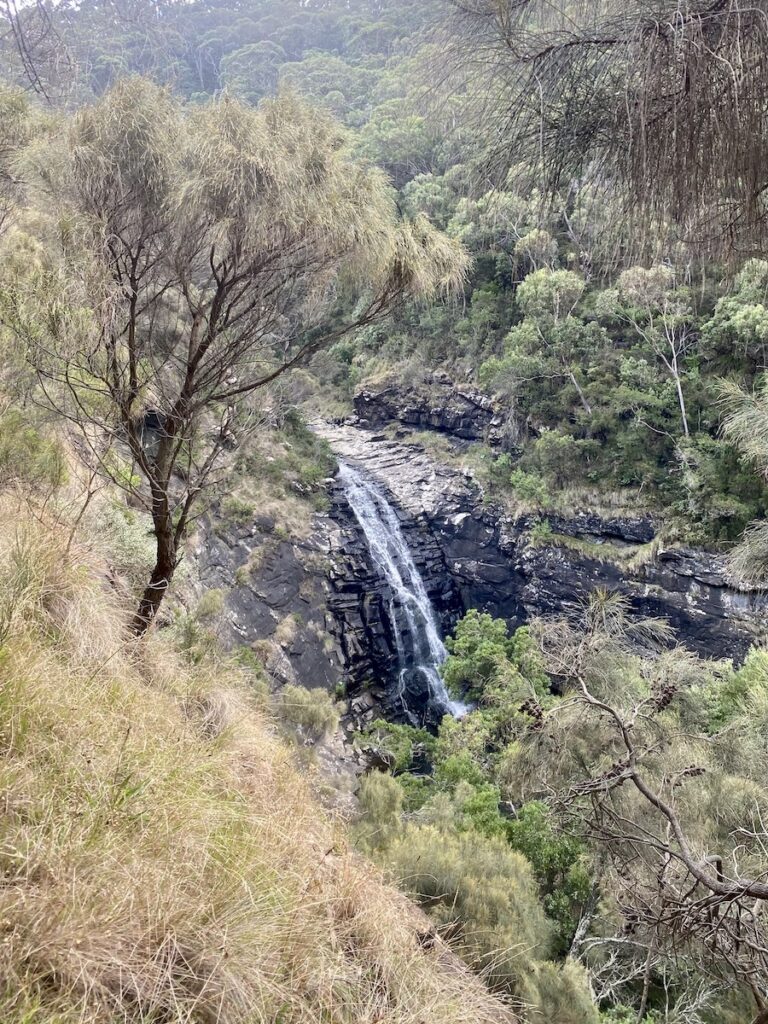
To be fair, the scenery’s pretty impressive. The tortuous track hugs a steep and rough hillside, with Sheoak Creek below. Swallow Cave’s probably not the most exciting natural feature in the world. However the walk up is worth the effort – it’s rugged country in here.
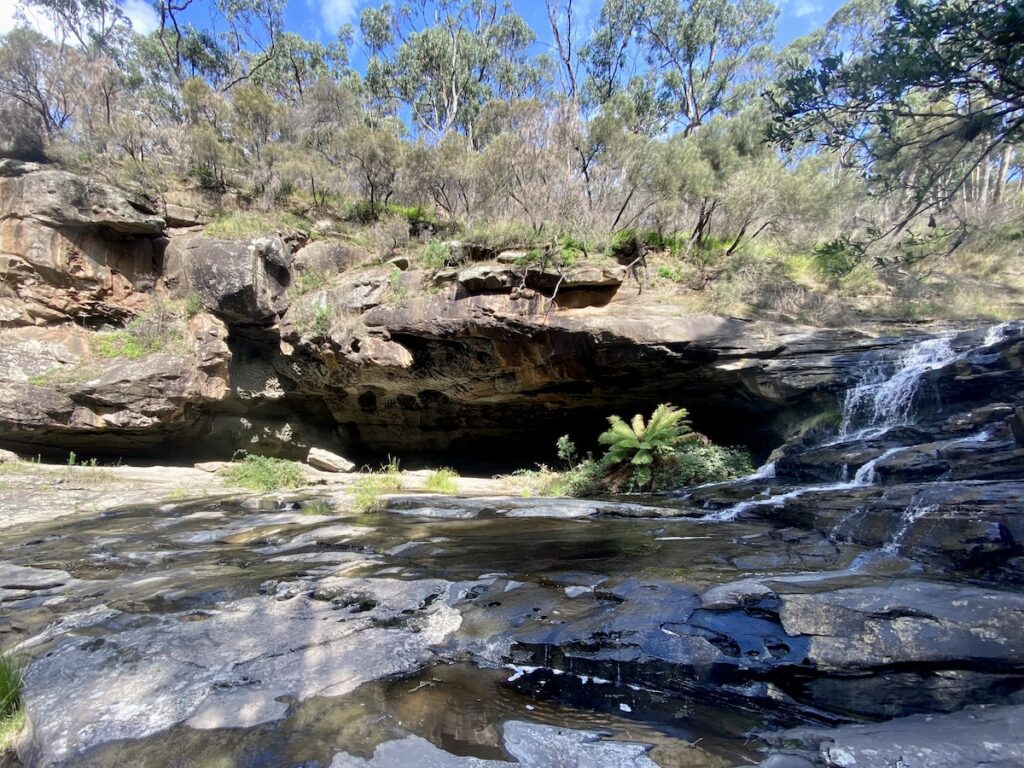
You can continue on to Sheoak Picnic Area from here. Keep an eye out for koalas. We met a couple who had seen one on their walk from Sheoak Picnic Area.
Erskine Falls Walk
From Lorne: Difficulty – moderate, 6 hr, 15km return.
From Carpark: Difficulty – moderate, 30min, 1km return.
Either follow the track from the Erskine River in Lorne or drive to the carpark. We chose the easy option!
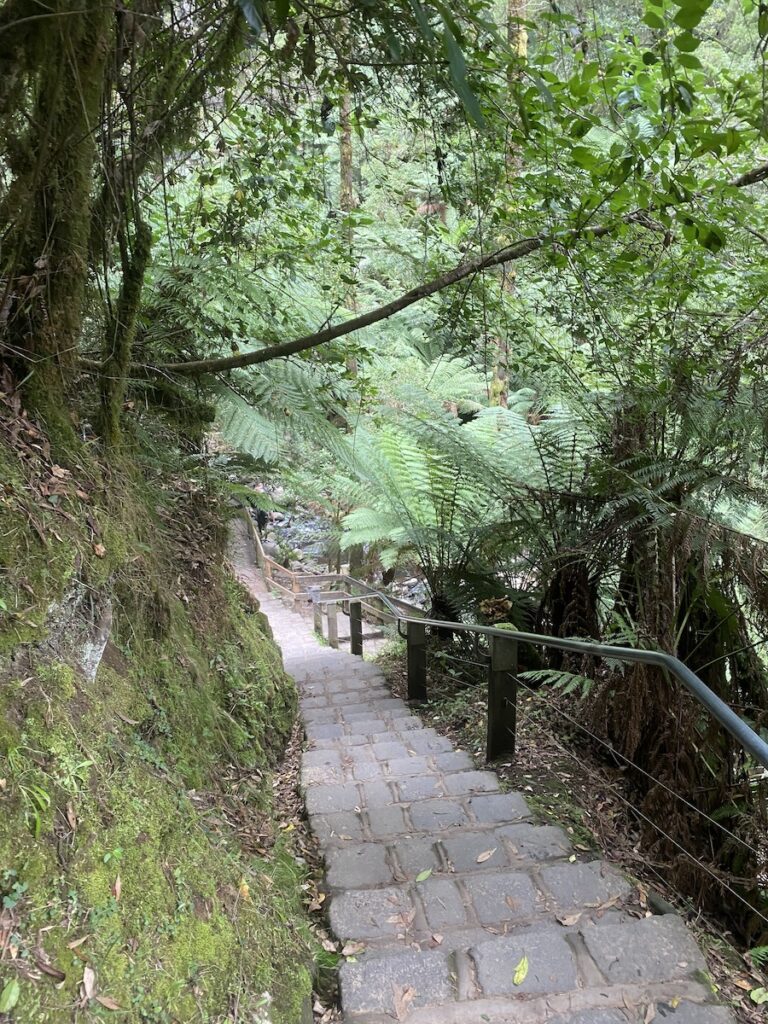
Over 200 stone steps wind down to the base of Erskine Falls. It’s a busy place, being so close to Lorne. Tourists of every description were taking in the views and generally enjoying the beauty of the dense rainforest.
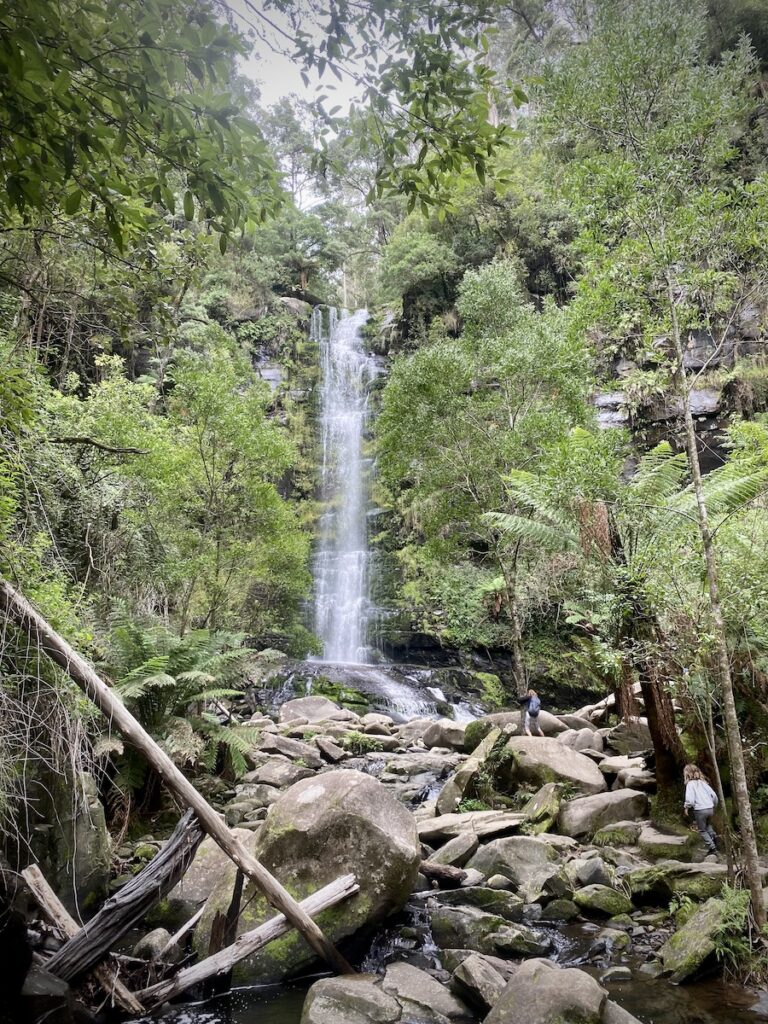
Stevensons Falls Walk
Difficulty – easy, 1 hr, 4.6km return from campground.
Take an easy, well-formed walking trail from the campground upstream to Stevensons Falls. This easy track mostly follows the Gellibrand River through rainforest and an open section of sequoia trees.
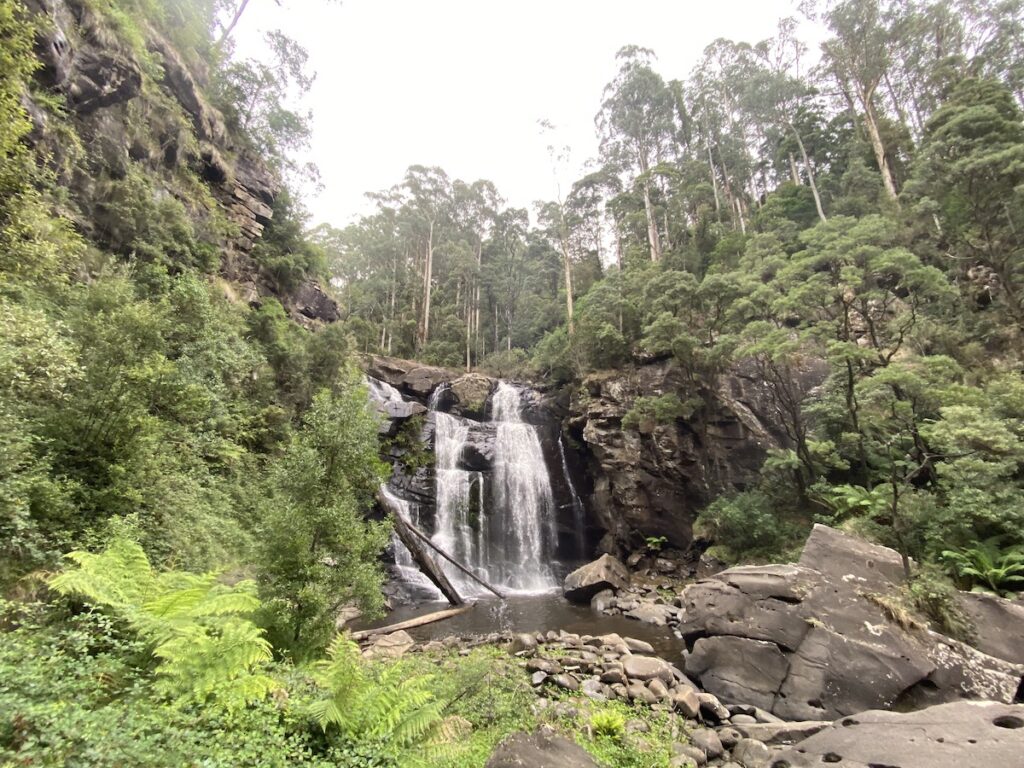
The highlight for us was the river. It makes its way through rainforest, with large tree ferns and a wealth of other vegetation pushing down to the river banks.
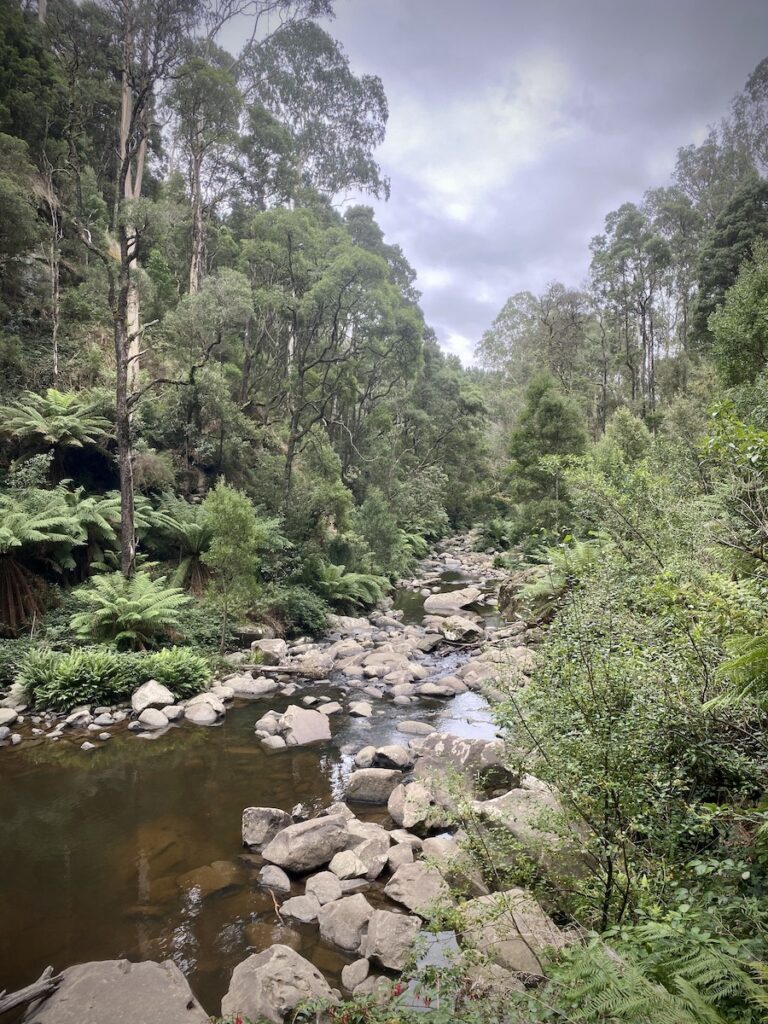
Hopetoun Falls Walk
Difficulty – moderate, 15min, 600m return.
The track drops quickly into a magical rainforest gully, following Aire River to the Falls. An upper viewing platform affords a great view of Hopetoun Falls on your descent.
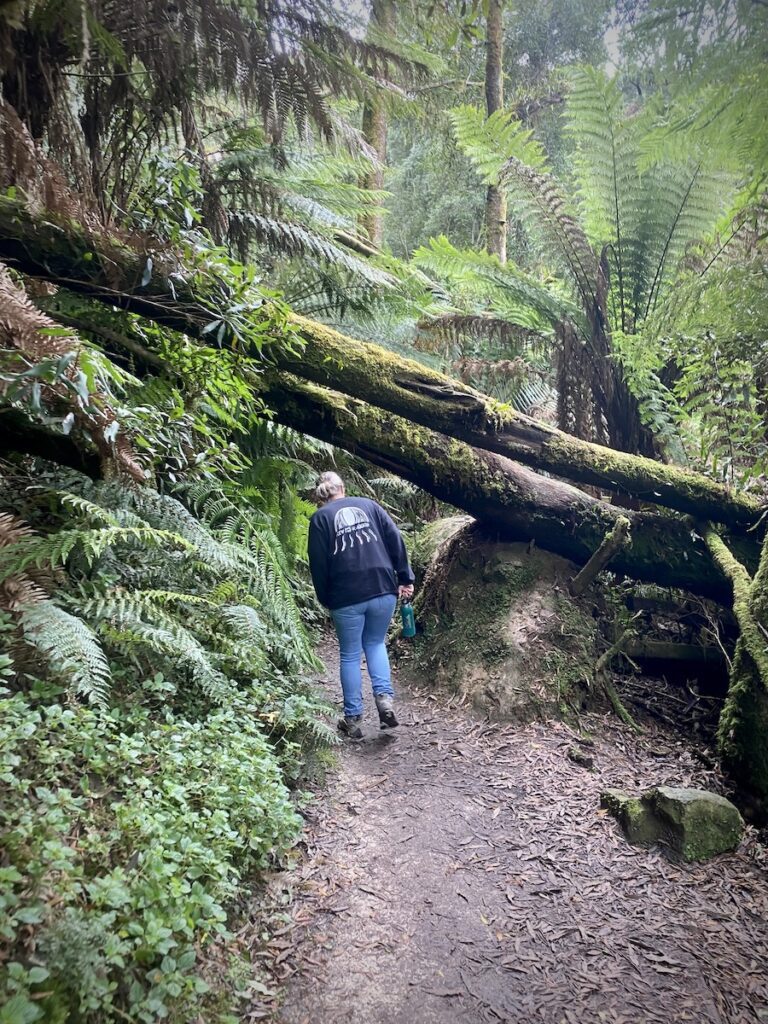
Californian Redwoods
Difficulty – easy, 10min, 500m
Not really a walk… however you need to walk into the plantation of Californian Redwoods to appreciate their size and beauty. Planted in 1935, some of these trees are now over 60m high.
Why were they planted? Native trees disappeared quicker than they could grow, due to intensive logging. So this grove is one of several experimental plantations grown to find a quicker-growing alternative to native trees.
Walking into the grove feels like you’ve walked through a curtain into another world.
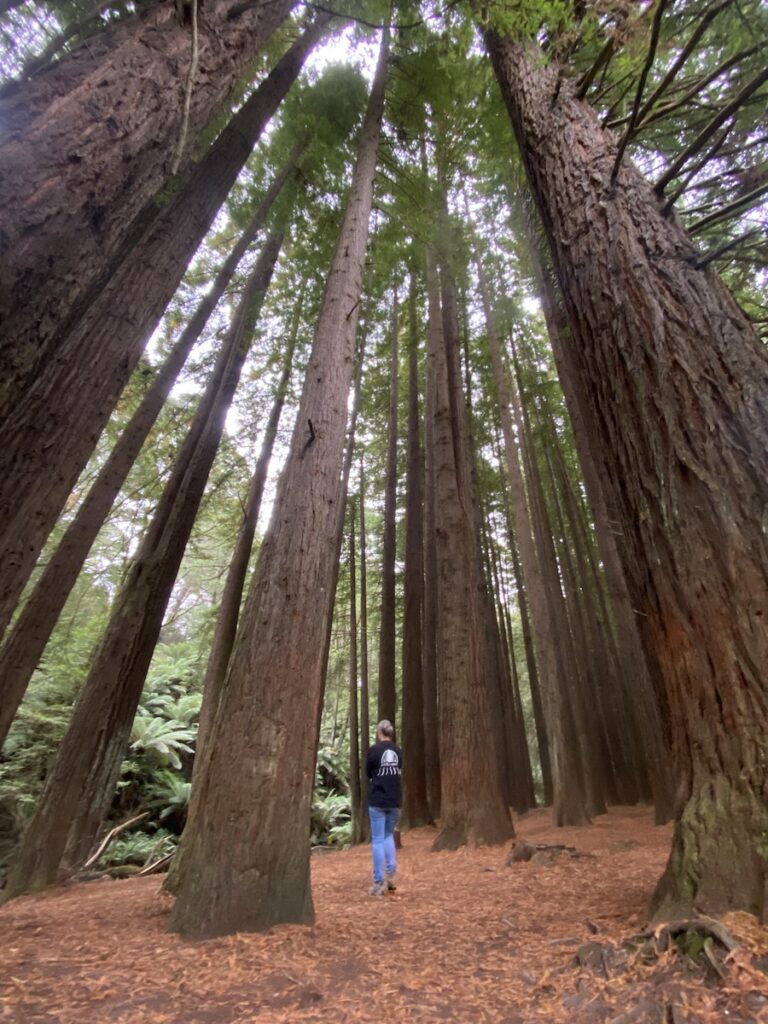
Triplet Falls Walk
Difficulty – moderate, 1hr, 2km circuit.
Triplet Falls was the site of one the biggest sawmills in the Otways. It’s located south-west of Beech Forest, a small town named after the myrtle beech trees which used to grow in the area. Sadly, there are none left in or near the town now.
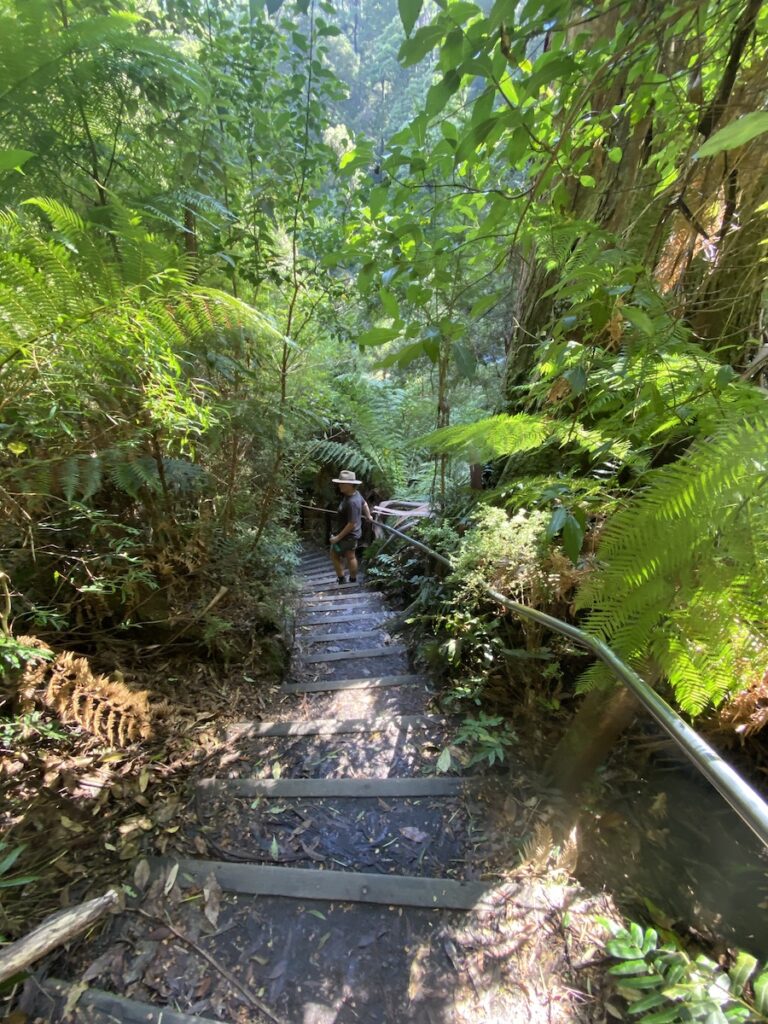
The Triplet Falls walk descends into a steep rainforest gully via steep steps. Keep an eye out for the huge mountain ash trees which form a critical canopy for the rainforest below.
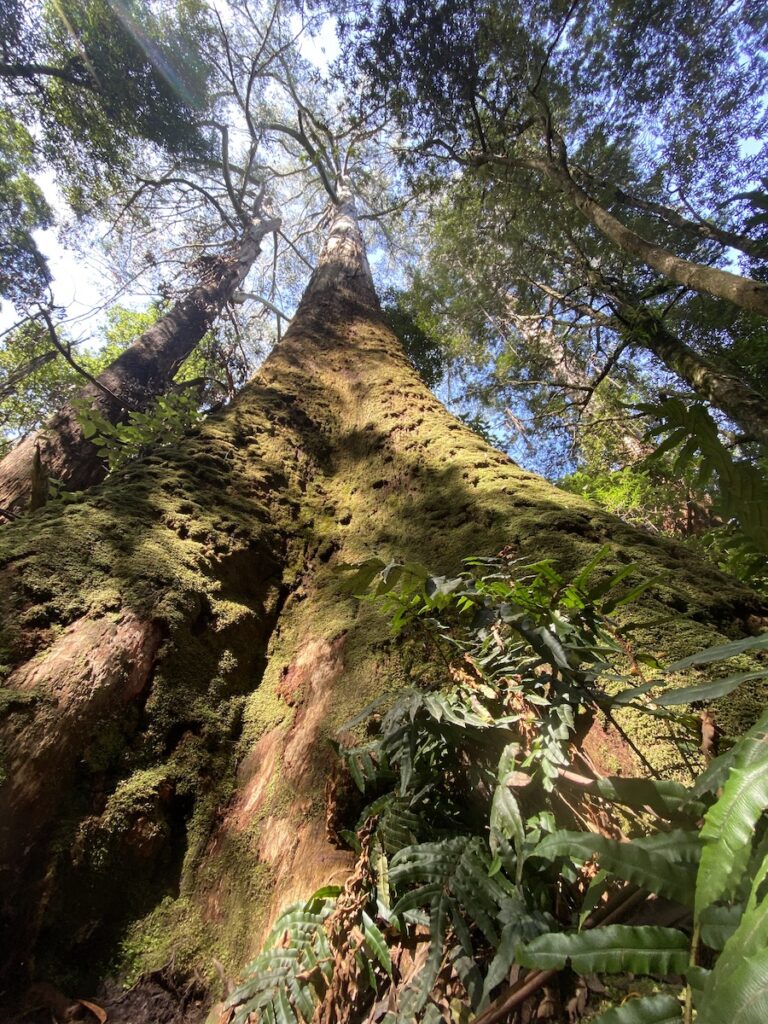
Madsens Track
Difficulty – moderate, 30min, 1.5km loop.
About 2.5km out of Lavers Hill when approaching from the west is a turnoff to Melba Gully Road. At the end you’ll find Melba Gully and the walking track.
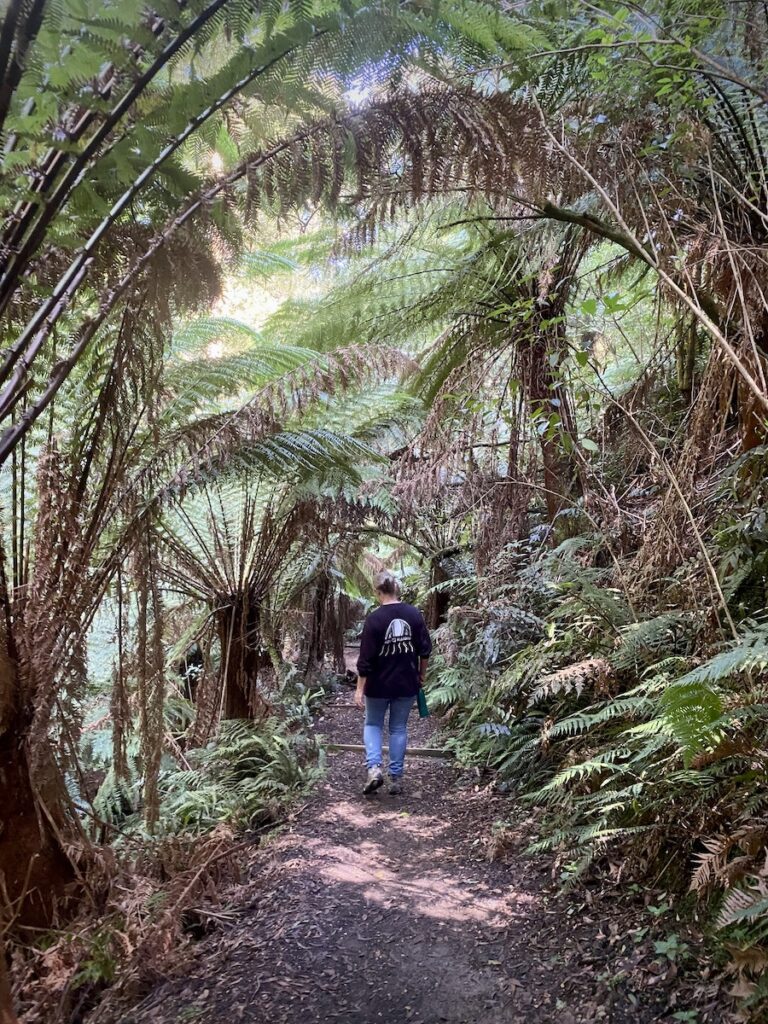
The track follows a tramway built for collecting logged timber. In the 1930’s, a lady called Jessie Fry built a tearoom for tourists and travellers. In 1958, the Madsens bought the 40 acre block then donated it to the Victorian Conservation Trust in 1975. It has since been integrated into Great Otway National Park.
This is a magnificent walk. It’s a dense stand of rainforest, protected by steep mountains all around.
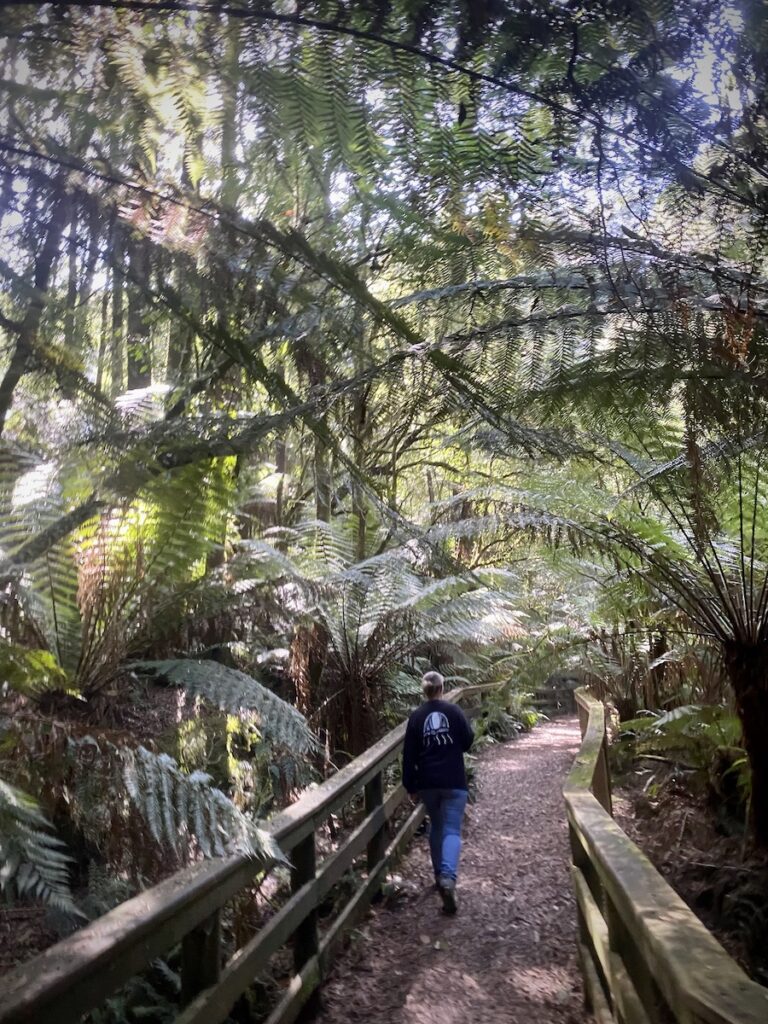
A Rainforest Wonderland
Great Otway National Park is a special place. We did twelve walks… yet hardly scratched the surface. We drove up, down and all over the Otways… yet didn’t get a chance to explore most of the 4WD tracks.
Yes, it gets crazy-busy on weekends and holidays. But when you combine the sensational scenery along the Great Ocean Road with the incredible beauty of the rainforests in the Otways National Park, it’s a magical place to visit.
Great Otway National Park is on Wadawurrung, Eastern Maar & Gunditjmara Country.
If you’re searching for camping gear and accessories, Outback Equipment has a wide range available. Go here to find out more.
Looking for more great articles on Victorian National Parks? Then go here.
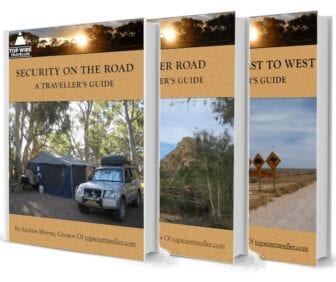
Get your Traveller’s Guides
… and a whole lot more at our FREE RESOURCES Page!
Any questions or comments? Go to the Comments below or join us on Pinterest, Facebook or YouTube.
Any errors or omissions are mine alone.

